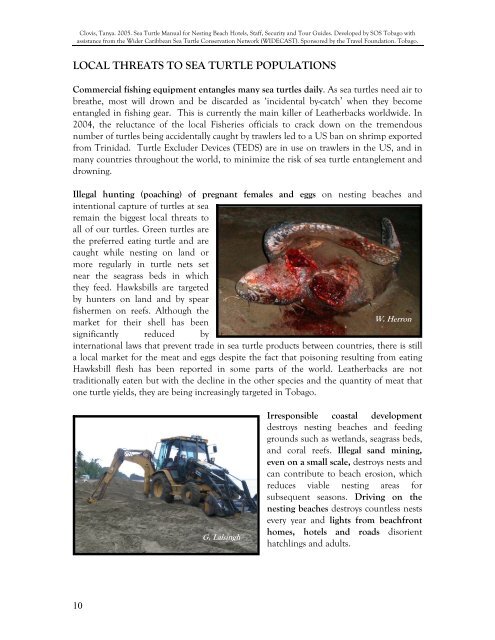Clovis, Tanya. - WIDECAST
Clovis, Tanya. - WIDECAST
Clovis, Tanya. - WIDECAST
You also want an ePaper? Increase the reach of your titles
YUMPU automatically turns print PDFs into web optimized ePapers that Google loves.
<strong>Clovis</strong>, <strong>Tanya</strong>. 2005. Sea Turtle Manual for Nesting Beach Hotels, Staff, Security and Tour Guides. Developed by SOS Tobago with<br />
assistance from the Wider Caribbean Sea Turtle Conservation Network (<strong>WIDECAST</strong>). Sponsored by the Travel Foundation. Tobago.<br />
LOCAL THREATS TO SEA TURTLE POPULATIONS<br />
Commercial fishing equipment entangles many sea turtles daily. As sea turtles need air to<br />
breathe, most will drown and be discarded as ‘incidental by-catch’ when they become<br />
entangled in fishing gear. This is currently the main killer of Leatherbacks worldwide. In<br />
2004, the reluctance of the local Fisheries officials to crack down on the tremendous<br />
number of turtles being accidentally caught by trawlers led to a US ban on shrimp exported<br />
from Trinidad. Turtle Excluder Devices (TEDS) are in use on trawlers in the US, and in<br />
many countries throughout the world, to minimize the risk of sea turtle entanglement and<br />
drowning.<br />
Illegal hunting (poaching) of pregnant females and eggs on nesting beaches and<br />
intentional capture of turtles at sea<br />
remain the biggest local threats to<br />
all of our turtles. Green turtles are<br />
the preferred eating turtle and are<br />
caught while nesting on land or<br />
more regularly in turtle nets set<br />
near the seagrass beds in which<br />
they feed. Hawksbills are targeted<br />
by hunters on land and by spear<br />
fishermen on reefs. Although the<br />
market for their shell has been<br />
significantly reduced by<br />
international laws that prevent trade in sea turtle products between countries, there is still<br />
a local market for the meat and eggs despite the fact that poisoning resulting from eating<br />
Hawksbill flesh has been reported in some parts of the world. Leatherbacks are not<br />
traditionally eaten but with the decline in the other species and the quantity of meat that<br />
one turtle yields, they are being increasingly targeted in Tobago.<br />
W. Herr<br />
on<br />
G. Lalsingh<br />
Irresponsible coastal development<br />
destroys nesting beaches and feeding<br />
grounds such as wetlands, seagrass beds,<br />
and coral reefs. Illegal sand mining,<br />
even on a small scale, destroys nests and<br />
can contribute to beach erosion, which<br />
reduces viable nesting areas for<br />
subsequent seasons. Driving on the<br />
nesting beaches destroys countless nests<br />
every year and lights from beachfront<br />
homes, hotels and roads disorient<br />
hatchlings and adults.<br />
10
















